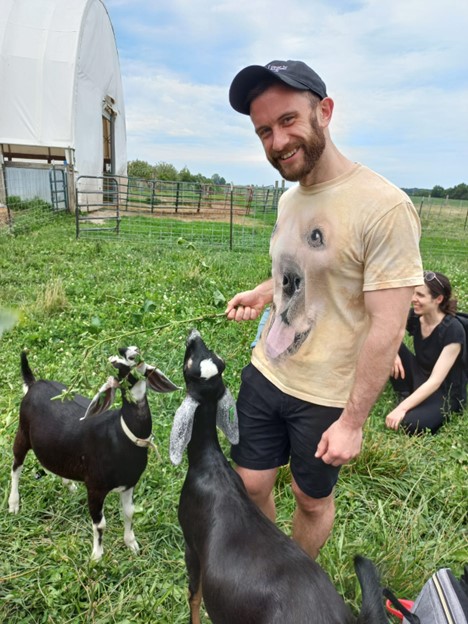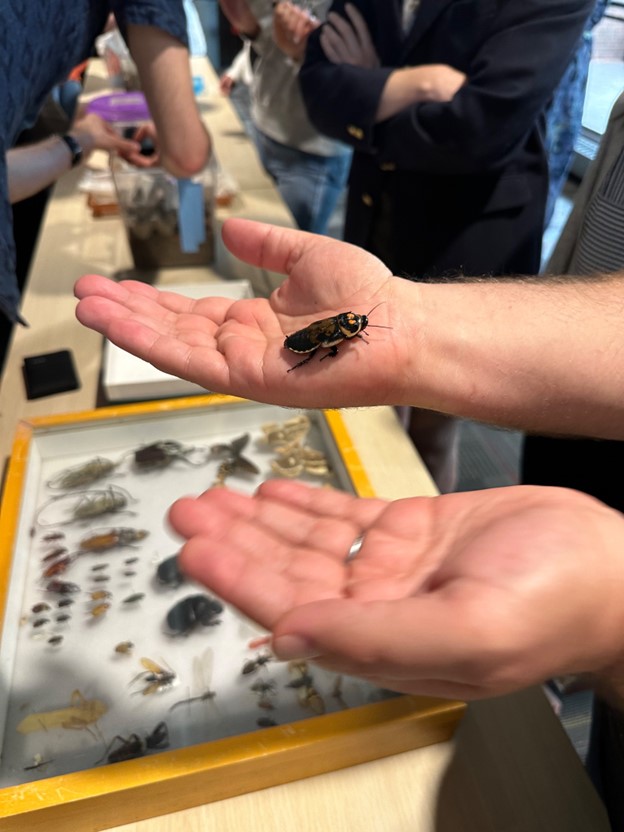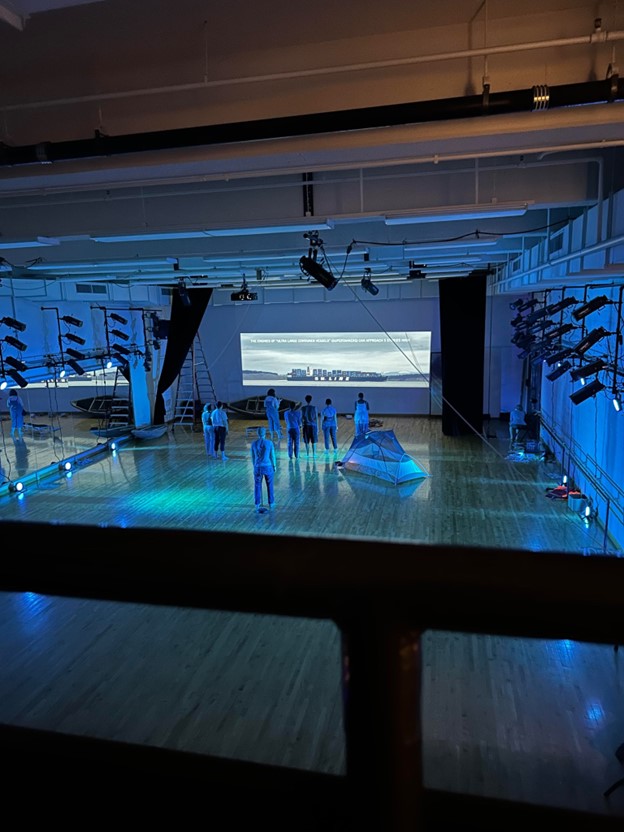Our “Hidden Gills”: A Report on the 2023 Animal Studies Summer Institute
Richard Fadok09/04/2023 | Report-Backs
Most days I struggle
to catch ragged breath
above the surface.
A crawdad’s call
reminds me I was born
underwater.
I need only relax,
slip below, and breathe
with hidden gills.
— Jenny Davis (2022), “Submergence”
After a three-year pandemic hiatus, the Fifth Annual Animal Studies Summer Institute (ASSI) reconvened with a roar this past July. Setting the tone for seven days of multi-modal inquiry into human and animal relations, the artist-anthropologist Jenny Davis opened with a poignant reading from Trickster Academy. In this poetry collection, Davis reclaimed the trickster—a figure of Native American oral traditions that science and technology studies (STS) scholars have appropriated as a metaphor for the subversion of social order—to voice her everyday experiences of “violence, survival, [and] refusal” as an Indigiqueer person in the academy. A member of the Chickasaw Nation, Davis spoke of the heartrending pain of discovering the skeletal remains of American Indians who had been boxed up and “slotted for study,” humans “rendered animal” by the anthropological gaze. Yet just as Davis depicted the ontological charge of being-animal as the debasement of Indigenous people and the denial of their humanity, so too did she cast bonds with individual animals as pathways to becoming more human. Crows send messages; coyotes nurture ties; and crawdads remind Davis of her “hidden gills,” her hidden potentials. Varied in tenor and prescient in topic, the poems that Davis shared with us anticipated the myriad relationships between human and nonhuman animals that we would discuss throughout the ensuing week—unequal relationships, marked by difference and rooted in power, that always contained within the germs of change.
An Animal (Studies) Sanctuary
Over the past decade, the University of Illinois Urbana-Champaign has become a leading academic center for animal studies, and the round barns and stock pavilion of this historic land-grant university were a fitting backdrop for the lively herd of conversations we had around multispecies encounters and entanglements in agriculture, science, entertainment, commerce, and domestic life. For the lion’s share of participants who assembled for ASSI, this was their first time meeting fellow animal studies scholars. Their home disciplines, I heard more than once, were mostly indifferent and sometimes hostile to their interests—a consequence of the nonhuman’s long-standing exclusion from the social sciences and the humanities. By herding together disciplinary runts from anthropology, sociology, American Studies, ethnomusicology, cinema studies, psychology, English, geography, education, communication, urban planning, and history, the ASSI’s co-shepherds Jane Desmond and Kim Marra sought to provision an intellectual sanctuary for us doctoral students, postdoctoral fellows, and junior faculty to connect and deepen one another’s scholarship. In total, they invited 22 scholars from private and public institutions of higher learning around the Global North, including early-career researchers from the United States, England, Scotland, Ireland, Germany, Switzerland, Italy, Poland, Australia, and Japan (Figure 1).

Figure 1: The 5th ASSI cohort (photo credit: Austin Hoffman)
With bellies full of vegan food, we communed in the spirit of what Desmond described to us as “interdisciplinarity with ethical integrity.” That is to say: We read and commented upon each other’s pre-circulated papers with interpretive generosity and an open mindedness unobstructed by the blinkers of discipline. We also attended plenaries from invited speakers (summed in greater detail below), a panel on publishing in animal studies journals, and three workshops on public scholarship, writing, and engagement. In between traditional academic programming, we met working goats and their kids at the Prairie Fruits Farm and Creamery (Figure 2), an Animal Welfare Approved farm, and handled cockroaches and other insects kept by the Department of Entomology (Figure 3).

Figure 2: Author with goat-nip, or mulberry (author’s photo)

Figure 3: Ethno-entomological contact (author’s photo)
Bestial Technoscience
Although science and technology was not its primary focus, much of the ASSI’s subject matter overlapped with the present concerns of the science and technology studies community. (This is perhaps not surprising, given the ineluctable presence of animals in STS theories since the late 1980s and early 1990s, from Michel Callon’s scallops and Donna Haraway’s primates and canines to Robert Kohler’s flies and Brian Wynne’s sheep.) Moving beyond the now-commonplace acknowledgement of nonhuman agency, we grappled with the role that technoscience plays in asymmetries between humans and animals, especially how scientific epistemologies and techniques premised on their separation have been crucial to the operations of settler colonialism, capitalism, and the nation-state. While the field of animal studies has faced criticism in the past for ignoring how power dynamics between humans shape human-animal relations (and vice versa), ASSI participants attended to the nexus between species, race, gender, Indigeneity, and other categories of social difference. If acts of violence toward animals and the animalized formed one pole of our dialogue, another coalesced around care, kinship, and the possibility of doing politics otherwise. Justice and injustice: these terms orient one convergence of STS and animal STS, now and into the future.
Multispecies Injustice
One of our concerns was the extent to which scientific discourses have both guided our knowledge about animals and patterned our interactions with them, particularly within industrialized agriculture.
As Ali Ryland revealed in her account of early modern agricultural manuals in England, it was Rene Descartes’ dualistic philosophy—his distinction between self-conscious, cogitating humans and unfeeling animal automatons–that devalued women’s work as milkmaids and transfigured cows from living beings into mere “fleshy machines for milk production.”
Following Ryland, other participants implicitly and explicitly traced how a human-centered Cartesianism has ramified in practices of animal possession, husbandry, and consumption. Andrea Knörr surveyed how mechanistic beliefs about animal psychologies inform the approval of livestock keeping practices in Switzerland. Guillem Rubio-Ramon interrogated how the industrializations of pigs and salmon have anchored the nation-building projects of Scotland and Catalonia, respectively. Not unlike Rubio-Ramon, Catriona Paul scrutinized how horses have cinched the spread of American settler colonialism.
During his plenary, however, Dinesh Wadiwel pushed back against the general assumption that an anthropocentric worldview alone underlies animal agriculture today. He argued that our dependence on livestock is not just an effect of a frame of mind but also of the value-generating labor that animals perform. For Wadiwel, the liberation of animals must go hand-in-hand with anti-capitalist movements. Lexi Garay, a humane educator, also probed animal agriculture as a multi-causal social problem in her auto-ethnography of meat consumption.
Despite its continued import, the Cartesian paradigm of human-animal division was not the only scientific epistemology that we examined. Mo O’Neill pointed to one alternative: the evolutionist thought of Edward Carpenter, a Victorian activist who likened human to animal, albeit ambivalently, asserting their natural unity while reinscribing the superiority of human self-mastery. Robert Mitchell gave us others in his plenary on the psychology of self-awareness and self-recognition in animals—a growing field that, despite its theoretical “messiness,” attributes greater mental depth to the nonhuman than Descartes would have ever admitted.
Nor was agriculture the only domain in which we witnessed how science has authorized violence against animals. Dominic Dongilli, in his history of the late 19th century zoologist and taxidermist William Temple Hornaday, recorded how efforts to shore up a white masculinity threatened by industrialization led to the hunting, capture, and display of the American frontier’s vanishing wildlife. May Berenbaum’s plenary chronicled how epidemiologists in the United States legislated eradication campaigns against house flies after vilifying them as disease vectors in the early 1900s. Lindsay Palmer questioned present-day relationships between Skinnerian behaviorism, toxic masculinity, and aversive training methods, such as leash-jerking.
“Multispecies Justice”
Yet against the staggering realities of multispecies injustice, many held space, not just for survival, but for refusal, resistance, revolution—that is, for the prospect of better relations with nonhuman animals, better worlds forged through moments of caring, kin-making, and political struggle.
On an ordinary, individual level, Ondine Sherman queried whether “direct animal experiences,” or face-to-face encounters with nonhumans, could turn people toward animal protection and veganism.
Jessica Austin approached the matter from the perspective of professions: How do vets, she asked, fashion their sense of self through the animals they tend to? Likewise, Sara Kaufman investigated the moral quandaries and communicational issues around end-of-life care that advances in veterinary science have engendered. Without denying the value of responsibilities beyond the human, Kat Poje emphasized in her history of “humane” technologies in the United States (e.g., the electric cage) that care and violence are wired together, materially and affectively.
Chris Green steered our analysis from the individual to the collective in his plenary. Based on his advocacy work with the Animal Law & Policy Program at Harvard Law School, Green outlined seven political “strategies” for enacting better animal welfare policies.
In between individual encounters and collective action, artistic practice also emerged as a means for a rapprochement between humans and animals.
Some paged through the literary arts for ways of representing the nonhuman. Magdalena Jagodzka considered how narrative and other rhetorical devices in Canadian literature (for instance, Margaret Atwood’s MaddAddam trilogy) portray animal particularity. Lisa Bölinger pondered the ability of literature to visualize the phenomenology of extinction in the American evangelist Fred Bodsworth’s Last of the Curlews. John Hawkins read American works of fiction that imagine alternate, if imperfect, bonds between humans and animals—works like Zora Neal Hurston’s Their Eyes Were Watching God. Valentina Romanzi thumbed through Brooke Bolander’s The Only Harmless Great Thing and Laura Jean McKay’s The Animals in That Country to uncover how contemporary dystopian writers envision interspecies communication and its significance to the formation of kinship.
Others painted the visual arts as re-mediation tactics. Deirdre Smith, in her reading of Juliana Huxtable’s exhibition Infertility Industrial Complex, limned its “zoomorphic feminism” as a protest against the intersecting oppressions of speciesism, racism, and transphobia. Yuping Hsu’s study of Twelve Nights–a documentary about the abject conditions of an animal shelter in Taiwan–exposed the power of film to transform popular opinion and influence legislative decision-making, namely the country’s euthanasia policy. Amanda Cortez presented an anthropological project on Peru’s tourism industry that used photography to counter state discourses about Quechua women and their animal companions. My own paper ethnographically analyzed three architectural installations at the Brooklyn Botanic Garden built for avian inhabitants. Their vision of a multispecies built environment dovetailed with Vinisha Basnet’s proposal for a more-than-human conception of urban planning that recognizes the co-constitution of different forms of life (in her case: crows and the silk-producing Kond people of Eastern India).
Three final contributions on the performing arts shined a spotlight on the past, promise, and peril of positioning animals center-stage. Kim Marra, in our last plenary, screened clips from her documentary The Pull of Horses to show how gender identity in late 19th century America tacked on the back of equine labor in theater, sport, and the circus. “Big Fred,” the scale model of an American Standardbred that she constructed for an exhibition of the same title, presided over the week’s proceedings (Figure 4). Similarly, Deke Weaver offered us a preview of Cetacean (Figure 5); the latest entry in his Unreliable Bestiary series, this multi-media performance dove into the toxic legacy of consumer capitalism and the multiple registers—mythological, economic, taxonomic, legal—in which whales breach human society. In an ethnomusicological riff on freestyle dressage and nonhuman musicality, Jack Harrison cautioned that the staging of animal agency frequently masks its all-too-human choreography.

Figure 4: An equestrian’s perspective (photo credit: Austin Hoffman)

Figure 5: Cetacean rehearsal (author’s photo)
Crossing Disciplines, Crossing Species
What animated our interdisciplinary exchange, then, were human-animal relations in all their facets, biological and cultural. These were power-laden relations: relations reared in the constitutive matrix where “species” meets axes of social inequality, histories of race, gender, class, Indigeneity, and sexuality. They told of domination and of oppression but also of hope and of healing. They pointed to our differences and limitations as much as our cross-species affinities and latent capabilities—in short, to our hidden gills.
Acknowledgements
The ASSI would not have been possible without the tireless assistance of Austin Hoffman; the institutional support of the Center for Advanced Study; and the generous patronage of the Brooks Institute for Animal Rights Law & Policy, whose contributions funded travel and accommodations. Thanks are also owed to the other participants, for sharing their brilliant scholarship and for granting their keen editorialism on this post.
Bio
Richard Fadok is an Assistant Editor for Backchannels. He is an anthropologist of design and multispecies ethnographer whose scholarship explores how the built environment mediates human and animal relationships in the United States. He is starting a postdoctoral fellowship with the University of Rochester Humanities Center, where he will be working on two book projects, one on biomimicry and another about habitecture. Richard was previously a Mellon Postdoctoral Fellow at the University of Pennsylvania. He received his PhD in History, Anthropology, and STS from MIT; a master’s in Biomedicine, Bioscience, and Society from LSE; and two bachelor’s in Neuroscience and in Science, Technology, and Society from Brown University.
Published: 09/04/2023
